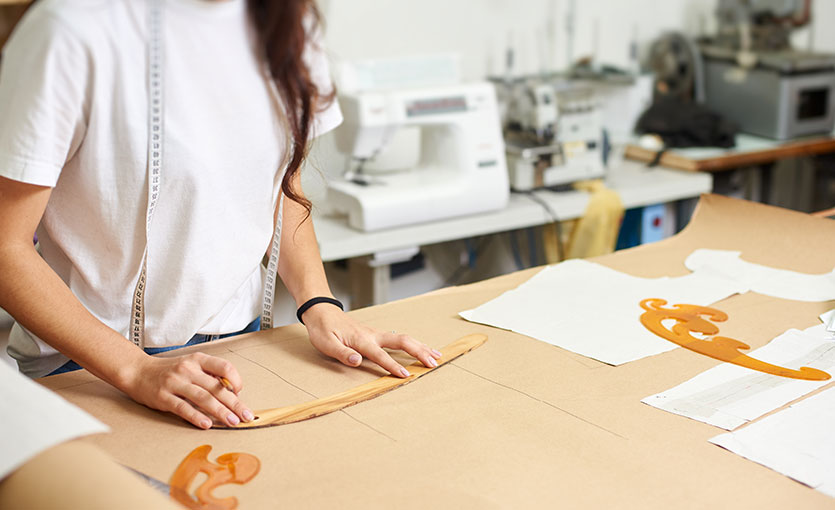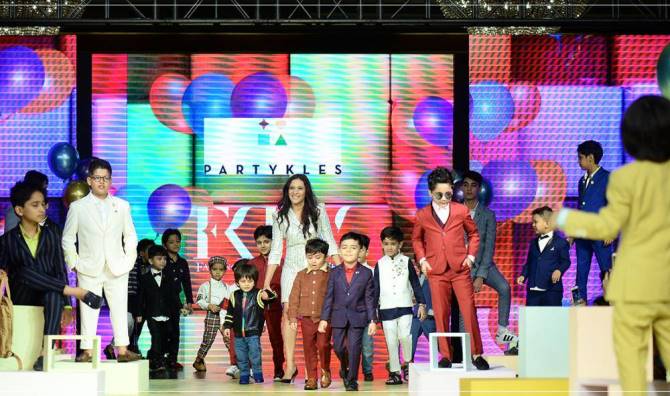Fashion Designing is an art, a dream, and a vision to revolutionize apparel designs aesthetically. It is the soul of the entire fashion industry. Just imagine how the world may look without the hues of colors and beauty! Similarly, how uninteresting it is to see everyone in the same attire. With the dawn of civilization, fashion sense started attracting people and took shape in different ways and forms in different eras. However, the concept of obtaining fashion design degree or education emerged with the modernization of society. Fashion has now become a full-fledged industry.
The history of fashion design dates back to 1826. Charles Frederick Worth is considered the first fashion designer of the world who started a fashion house in Paris. No wonder why Parish is the international fashion capital. It was during the middle of the 20th century that fashion houses from the streets of Paris started mass production of fashion garments. Since then, the wave of fashion never stopped.
It encroached massively from rare few to everyone and became accessible to a larger public. The revolutionizing fashion trends received so much love and acceptance that it became a lifestyle among people from different geographical conditions. It largely added to the world’s GDP by also creating employment opportunities for keen fashion enthusiasts. Since the fashion design industry broadened its horizons, specializations in varied categories of clothing came into existence. Fashion trend like men’s wear, women’s wear, lingerie, bridal wear, kid’s wear, handbags, footwear, and accessories, etc. emerged to remain forever.
Fashion Design in Modern Times
Modern fashion design can be categorized into ready-to-wear and haute couture. The intricate developments in the fashion design industry gave a boost to other career paths like fashion journalism, fashion photography, fashion advisory, hair, and make-up artisans, etc. Due to having core skills and understanding today, fashion designers have more career choices than the earlier times when most of the fashion designers were independent freelancers. Today, fashion design degree or diploma holders can get a competitive-edge over their counterparts, especially during promotions. Added to their enhanced skills and understanding of fashion business, individuals equipped with special training are preferred among others.
Today, the work has become more streamlined with the synchronization of the fashion industry. Need for various fashion assistants to stylists to managers to entrepreneurs and so on has emerged. Hence, the competition has increased among the fashion corporates, professionals and scholars. It allowed global fashion schools to enhance the training structure with an innovative curriculum in fashion design. The upcoming fashionistas must have a good hold of fashion trends for emerging as fashion leaders.
Career in Fashion Design
Fashion design professionals should have an in-depth understanding of different weaves, fabric, texture, prints, colour, style and fashion trends with a sense of analyzing the upcoming trends profitably. After all, the success of a brand depends upon the selection and approval from the fashion designers through various levels. By obtaining a career in fashion design, one doesn’t only get to work as a fashion designer alone. There are certain sets of duties, leverages and perks that come along. A fashion design degree offers enormous career opportunities with fashion houses, big apparel or accessory brands, and industries, etc. Let’s ponder upon what job titles one may acquire after pursuing a course in fashion design.
- Fashion Designer: Anyone with a qualification in fashion design can opt for either starting his label or may join a fashion enterprise and render designing services. A fashion designer works on styling different apparels that come under various clothing categories.
- Technical Designer: A technical designer is responsible for creating a technical package. They decide every detail about a garment/accessory under construction. It may range from fabric selection to stitching instruction to points of measurements to placement or even packaging instructions.
- Fashion Marketer: As the title suggests, one can utilize his fashion design knowledge and understanding in marketing big fashion brands, retails or chain outlets. Anyone having a flair for marketing in the field of clothing, accessories or styling can become a fashion marketer with just right skills and persona.
- Quality Controller: A quality controller sets quality standards for the items to reach customer shelves. This involves issuing guidelines for each department from production to packaging to distribution and delivery. At every stage production gets quality-checked under the supervision of Quality controller.
- Fashion Stylist: Majorly fashion stylists are hired by celebrities who require them for enhancing their wardrobe and present them with a trendier selection in their closet. Fashion stylists are usually independent freelancers who work for one or more celebrities. Now a day, fashion consultants are evolving rapidly due to technology access and crunched distances. All thanks to social media.
- Fashion Concept Manager: A fashion concept manager has a heavy burden on his shoulders, yet this is an interesting profile for fashion design professionals. Concept manager is responsible for bringing revolutionized thinking and approach for new design under a brand name that is saleable as well as earns a good reputation for the label.
- Fashion Coordinator: As the title suggests, a fashion coordinator is responsible for integrating fashion range across all divisions of a retail outlet, fashion house, boutique or a fashion magazine. They play a vital role in helping their organization decide on the trending range in clothing and accessories.
Above listed titles are just a glimpse of title(s) that a student with a degree/diploma in fashion design may acquire after completing fashion studies. However, there are a lot of opportunities that the fashion industry has to offer to qualified individuals who have a zest for making it big in the industry. One may need to undergo thorough training and education to support their candidature for the awe-inspiring fashion world.
Fashion Design Degree and Courses at ICF
Do you have a flair for designing clothes or do you have a keen eye for the detailing of fashion accessories? If yes, then nobody can stop you from excelling in a career associated with fashion design. Often, fashion design is perceived as just designing clothes, however, it goes beyond the intricate designing. You can have a plethora of opportunities (also mentioned above) in front of you after obtaining the desired qualification in Fashion studies. Today, the time has changed and the fashion schools have revolutionized from just being traditional to completely modernized, having the modernized equipment, training methods and the curriculum.
Fashion students can choose from the wide variety of courses available at the respective institutions. The most sought-after fashion courses for students as well professionals are those that can fetch them employment or career growth respectively. The fashion industry is vast; hence the courses vary across different institutions. Fashion courses at the ICF are divided into two categories, viz., Undergraduate and Postgraduate Programs.
Undergraduate Programs Include:
- BBA in Fashion Entrepreneurship
- Diploma in Fashion Design
Postgraduate Programs Include:
- Masters in Fashion Entrepreneurship
- PG Diploma in Fashion Design
BBA in Fashion Entrepreneurship
The course duration for BBA in Entrepreneurship is 3-years. It is a degree program from UGC recognised Government University that combines Fashion Design with Entrepreneurship.
BBA in Fashion Entrepreneurship involves an extensive curriculum which has been developed by IIT Delhi, NID Ahmedabad & NIESBUD.
This is a job-oriented course which has been created to establish practical fashion skills and understanding about the brand and design.
Diploma in Fashion Design
Diploma in Fashion Design is a 1-year Diploma Program which is a UGC recognised program suitable for undergraduate students. Anyone having a keen interest in becoming a fashion professional after completing school has a golden chance to brighten their career in Fashion Design in an affordable manner.
Masters in Fashion Entrepreneurship
Masters in Fashion Entrepreneurship is a 2-years degree program in Fashion Entrepreneurship which is a UGC recognised degree program. Serious graduates who want to make a career in Fashion Entrepreneurship can opt for this program. Masters in Fashion Entrepreneurship nourishes your skills in understanding the fashion business environment, evaluating business opportunities, creating new ventures and fostering innovations in the fashion world.
PG Diploma in Fashion Entrepreneurship
PG Diploma in Fashion Entrepreneurship is a 1-year post-graduate diploma program which offers a UGC recognised qualification for the aspiring fashion students and professionals. It gives you access to cutting edge qualification which can be acquired in the least minimum time. This course is perfect for graduate students and working professionals as well as those on a break.
Fashion Design Subjects
General courses in Fashion Design includes the following subjects:
- Fashion and Art
- Pattern Drafting
- Creative Design
- Fashion Illustration
- Fitting
Fashion students get their hands-on exposure to the fashion industry through the following subjects included in their syllabus at various diploma, graduate or post-graduate level. The below list may vary as per different study levels and may include more subjects.
- History of Fashion Designing
- Fabrics and Raw Materials
- Clothing Design
- Pattern Making
- Surface Ornamentation
- Fashion Trend
- Fashion Photography
- Fashion Market
- Communication Design
- Accessory Design
- Fabrics, Prints and Raw Materials, etc.
- Partnership
- Business Management
- Consumer Behaviour
- Textile Management
- Garment Industry (Merchandising quality, industrial garment production, marker planning, etc.)
Everything today has revolutionized to technology. The fashion schools have also geared up with a couple of technological advancements in graphic design, adding following in the curriculum for their upcoming fashionistas.
- Construction Basics
- Textiles and Pattern Making
- Computer Assisted Drawing (CAD)
- Portfolio Development
Eligibility:
- For securing admission to BBA in Fashion Entrepreneurship, a student should have passed class 12th from a recognized board with 45 per cent marks. Students awaiting their board results may also apply.
- For securing admission to Masters in Fashion Entrepreneurship, a student should have obtained a graduate or an equivalent degree from a recognized university with a minimum pass percentage as 45%. Candidates awaiting their final year results may also apply.
Fashion Design Exams
The most important exams associated with fashion and design courses are AIEED, CEED, NID and NIFT. Students seeking admission in reputed college should undergo the common entrance examination and obtain a minimum score for consideration.
Also, many fashion schools/colleges conduct separate exams like IIT CEED, NID GDPD / PGDPD, and so on.
It is critical for a candidate to pass the minimum required criteria accepted by various colleges.
Chances of Success
It is important to learn that your success depends upon your choices. As you opt for a study in fashion design, you have to be very sure about your strengths and likings in this particular field. Also, at the same time, you will need to know about the pain points that may arise in the future. You have to set your mind before jumping on any conclusion. Any decision about your career in fashion or otherwise should be deeply thought before working out. One wrong decision can change your entire life. You may not likely to take that chance!
Hence, hold on and re-evaluate your decisions. Talking about success in the fashion industry, it is immense. It is so much that one may not get bored of this industry ever. First of all, it is an ever-evolving industry. It is very surprising how quickly the trends, tastes and consumer response and behaviour changes. It keeps the fashion professionals on their toes. A person with a love for dynamism is a perfect fit for the fashion industry. Since the change multiplies the chance of success and you can achieve it if you are quick to respond to changes.
You can inculcate great professional ethics by nurturing yourself under a highly esteemed fashion college. Do not just opt for a course to study but a complete culture that can bring out the right professional in you. Make a list of the colleges that you are planning to apply to, re-evaluate each one of them based on learning, education, class, popularity, placement records, alumni track and above all industry training. Yes, industry training is a LIVE experience that students get during their course time. It makes you develop a hands-on understanding of the real-world scenario. It prepares you for cracking interviews confidently. Do not just go by college popularity, evaluating certain parameters will give you a clear insight into the authority of an institute.
Today, the world is growing at a faster pace due to digitization. E-commerce and social media have allowed brands to evolve like never before. For instance, e-commerce shopping sites like Amazon, Flipkart, Myntra, etc. have given fashion professionals a plethora of opportunities.
Also, the consumer buying behaviour has impacted a lot through the use of social media and social app. The need for fashion professionals has witnessed an outstanding increase which will continue exponentially as the fashion industry broadens its horizons. This is a clear indicator that the demand fashion professionals will keep evolving with this industry.
Investing in fashion studies is surely about investing in your future for greater success.
Inspirational Personalities in Fashion Design
They are leading the Indian fashion industry with their exemplary work and performance at each sphere. With their hard work and dedication, they haven’t received love from their own country but from other nations too. They have international reach and are known as the best fashion designers in the fashion industry. Let’s uncover who:
Ritu Beri, Rohit Bal, Rina Dhaka, Abu Jani and Sandeep Khosla, Manish Arora, TarunTahiliani and Ritu Kumar.
They are the ones fashion students look up to for motivation and courage. To become as successful as them, one needs a keen eye on detail and right approach towards learning. Equipping yourself with a full-fledged qualification sets the base for achieving a lot more throughout your professional journey. Students are advised to learn from their hard work and get inspired by their work.
WHY ICF for Obtaining a Fashion Design Degree/Diploma?
International College of Fashion is more than just being a fashion institute. We are home to state-of-the-art facilities. Our students get exposure to deal with elite industry figures who hail from different backgrounds and reserves honorary positions in their respective working areas.
We have developed a new Fashion Entrepreneurship program under the guidance of exemplary industry figures in association with IIT-Delhi, NID- Ahmadabad and NIESBUD.
Our students not only obtain a fashion design degree or diploma but a handful of learning experiences which they get by involving in various industry training and internships conducted by the ICF. Our track record of successfully placed students is of an umpteen repute and we are counted among the best fashion colleges in India. A student who joins our college for either of the diploma or degree program(s) achieves exceptional learning, LIVE training, industry exposure and intricate professional mannerism with our off-class sessions.
We aim to develop future entrepreneurs in the fashion industry as this industry is rampantly evolving and the future will need more entrepreneurs to lead the world of fashion design. Our curriculum in Fashion Entrepreneurship is distinguished from other fashion courses due to the high volume of business management and partnership lessons. It will strengthen a student’s knowledge and understanding of the way fashion business operates in India and cross-borders. The future fashion entrepreneurs whom we develop today will bring delight to our nation by amalgamating the tradition, culture and fashion together to create new fashion horizons.
Please follow and like us:










